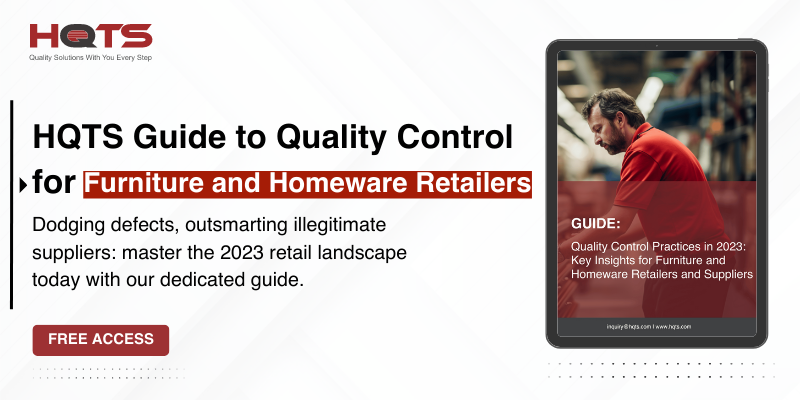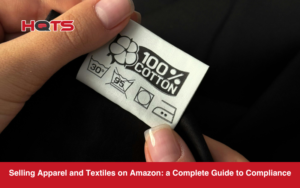Furniture is a necessity in any home and is a reflection of personal style and design. Furniture manufacturing in Asia and China can be challenging for retailers and online shops, who must ensure they remain unique and innovative, whilst they also have to consider consumer safety and ensure they meet time-to-market obligations. Essential elements in optimising their supply chains. Furthermore, quality control is a vital part of the furniture manufacturing process. Furniture production is moving to lower-cost manufacturing countries, so the need for reliable and professional furniture inspection has never been greater.
If you want to stay ahead of your competitors and ensure the quality of your imported products, check our Free Guide for Furniture Importers 2023 edition:
Identifying the different types of Furniture Defects
Importers may find buying furniture from Southeast Asian manufacturers a daunting experience, as the logistics, compliance and potential communication challenges could present difficulties and risks.
Clarifying the category of defects at the beginning of the importing process will help to speed up and clarify your furniture inspection report;
- Critical defect – resulting in hazardous and unsafe conditions for individuals using and maintaining the performance of the item. A critical defect contains one or more defects
- Major defect – a defect that is likely to result in failure or reduce the usability of the product
- Minor defect – one that is not likely to reduce the usability of the product and has little bearing on the effectiveness or operation of the product
The Root Analysis
The root analysis will help to handle any defective furniture products with your supplier.
- Problem recognition and definition – Acknowledge and define what the production problem is
- Identify the causes – Go through the process of cause identification
- Identify solutions – Based on your cause identification you will need to identify the best possible solutions to address the problem for now and the future
- Implement the solutions – The solution needs to be one that optimises and improves your operational processes
In order to identify and correct the different kinds of issues with the potential furniture suppliers HQTS can provide the next solutions:
DPI (During Production Inspection)
Carrying out inspections during the production process are critical steps as they will ensure your final piece of furniture will reach the expected level of quality and be ready for immediate shipment. DUPRO not only focuses on the finished products but also evaluates production status and quality controls that are implemented on the production line. Any defects with the products should be identified as early as possible and addressed on site and the inspection reports needs to include details of all the quality issues, no matter how small.
After receiving your DUPRO inspection report, you need to thoroughly go through every step addressing any issues that may have been found. You will need to review the products specification lists, which will give you a guide you to fix any items that have the ‘pending’ status.
PSI (Pre-Shipment Inspection)
A pre-shipment inspection of a small sample of your furniture, determines any quality defects that may have resulted from the production process. A random furniture sample will be selected and each one will be checked individually to identify any visual defects and while ensuring that the product meets the production specifications, verifying that the goods being shipped have been manufactured according to the requirements. Furniture not only needs to be stylish but also extremely strong and long-lasting, given the prolonged usage. In order to make sure that the furniture is free of all defects, it is common for importers to carry out pre-shipment inspections before the furniture is finalised for shipment. With the increasingly complex supply chain process, product recalls and returns, manufacturers, brands and retailers need to be confident that the products they deliver meet consumer expectations, global regulations and safety and quality standards. An inspection that takes place at a factory reduces the likelihood of risks and defects and ensures top-quality safety to workers and inspectors.
Check our Pre-Shipment Inspection Sample Report for furniture here:
|
Benefits of Conducting an Expert Furniture Inspection
- Visually inspect your product against CAD design sketches and samples, looking for aesthetic compliance and check for defects related to dimensions, discolouration, finishing, scratches, warping and any other visual imperfections
- On-site checks and tests are necessary for structural safety, achieved by load tests, impact tests, arm and leg strength tests and any other relevant stability tests
- Ensuring compliance to any legal standards such as those related to illegal logging, or wrong labelling of filling materials and the illegal use of textile fibres for upholstered products
- Packaging inspections to check for appropriate packaging of the furniture parts to protect against abrasion and climate impacts to prevent damage during shipping
- Lab tests, including flammability and fire resistance testing, chemical testing for lead content in surface coatings and pentachlorophenol and formaldehyde in composited wood products
The Furniture Inspection Report
Furniture inspection reports should be as detailed as possible and include;
- Inspection Information – clients name, suppliers’ information, product name, inspection date, inspector’s name, factory, quantity, location and the name of the staff member the product was reviewed by
- Reference Photo – one photo of the warehouse and one photo of the product
- Inspection Standard – inspection type, default levels, specify defects and level the defect by critical, major or minor categories
- Inspection Result – score the quantity, appearance, product style and colour, data measurement, packaging and shipping mark by ‘conform’, ‘not conform’ or ‘pending’
- Overall Conclusion – score the overall product using tick boxes
- Remark Points – write the remark point results including, moisture content test and any other remarks found
- Quantity Status – include the item types, shipment quantities, packed quantities and non-packed quantities
- Appearance/Functionality – attach any defect pictures with an explanation
- Product Style & Colour – checked against product specification information, pictures, samples and manuals
- Data Measurement – score each section using conform’, ‘not conform’ or ‘pending’ and include the detailed measurements of each product
- Packing Method – attach pictures of the packaging and shipping marks
- Additional Information – include any extra important information or pictures
Furniture report inspectors will ask a series of questions to fully understand the full history of the problem in order to compile an accurate final report. A furniture inspection checklist includes:
- Check the apperance and aesthetic of the goods, fabric, printing, painting, gaps, screw holes, hardware, glass, plastic, mirror and foam
- Metal detection check
- Zipper check
- Smell check
- Labelling/marking check
- Assembly check
- Stability check
- Loading test
- Size measurement check
- Barcode readability check
- Tape and rub test
- Moisture content check
- Sofa bottom spring and frame check
- Cushion stuffing check
- Carton drop test
- Carton size and weight check
- Quantity per carton check
To ensure the furniture report is accurate, each inspector will closely inspect the furniture looking at many key areas for structural points and potential weaknesses in the frame. The suspension systems will be closely inspected, types of springing systems noted and possible improvements will be pointed out. The fillings of cushions and casings will be inspected and fully checked for sectional failures or possible faulty batches. Fabric finish, type and wear qualities will be inspected as part of the report, checking for running faults, uneven wear paths and correct pile/shading direction will be monitored. Internal inspections of the piece or pieces are often necessary to ascertain the full extent of problems or causes. In some cases partial removal of the dust covering/platform lining will be necessary to gain access and will be properly re fastened as before.
Sourcing across Asia is not without communication and language barriers, with Vietnam, India and China fast becoming a popular destination for furniture manufacturing due to the low costs. Using a neutral third-party quality provider, who has the expertise in inspection and sourcing can ensure you will receive the best, top-quality products, as product specifications can be communicated correctly and clearly.
Factory Furnitures Audits
Furniture Factory Audits and supplier audits provide a detailed analysis of the condition, strengths and weaknesses of the supplier. This service can also help the factory to understand areas requiring improvement to better meet the importer’s needs.
The standard factory audit includes:
Manufacturer’s background
Manpower
Production capability
Machine, facilities & equipment
Manufacturing process & production line
In-house quality system such as testing & inspection
Management system & capability
Environment
Lab Furniture Testing
Independent furniture testing is extremely important before dispatching the goods to your clients as it will help you to ensure any issues are addressed at an early stage and help you save costs and time.
At HQTS, we inspect and test your furniture using many different methods, ensuring a top-quality testing approach;
- Formaldehyde – Wood Panel & Finishing Product:
- Chamber Method
- The Flask Method
- The Perforator Method
- Formaldehyde – Wood-Based Panel & Surface Decoration:
- Walk-In Chamber Reference
- The Flask Method
- The Perforator Method
- Formaldehyde – Indoor Based Furniture:
- The Flask Method
- PCP – Wood Preservative
- CU, CR, AS – Wood Preservative
- Soluble Lead, Cadmium, Chromium & Mercury – Paint on Furniture
Furniture Quality Standards
Finally we need to consider the internationally recognised standards that can be verified with inspections and testing on your furniture in order to ensure your products will be able to battle all the elements including, sun, rain, snow and wind.

ASTM F1561-03
The American Section of the International Association for Testing Materials (ASTM) develops international standards for manufacturing and testing products. It is used to assess the performance requirements for residential and non-residential outdoor plastic chairs.
Europe
In Europe, 49% of recalled furniture relates to outdoor products. Europe has two standards for outdoor furniture – EN 581-1 General Safety Requirements and EN 581-3 Mechanical Safety Requirements for Tables.
EN 581-1
The European Committee for Standardisation (CEN) sets the standard for the countries within the European Union. A set of standards have been developed to address all safety requirements for outdoor furniture.
- EN 581-1 provides the general safety requirements for outdoor furniture.
- EN 581-2 specifies the mechanical test methods to establish safety for outdoor seating furniture.
- EN 581-3 provides mechanical testing procedures for outdoor tables.
- EN 581-4 determines durability testing of outdoor furniture when exposed to environmental factors such as rain.
EN 581-3
EN 581-3 was updated in January 2017 and the requirements now provide greater clarity to various table types, including tables with and without extensions, longer tables and smaller tables etc. The revised version also includes demands for glass table-tops to ensure the holes for parasols are protected to prevent metal to glass contact.
AFNOR NF D60-300
The French Standardisation Association (AFNOR) develops safety standards applied in France, plus other countries globally. AFNOR NF D60-300 provides safety requirements and test procedures for outdoor seating and tables for children.
UL 962
Underwriters Laboratories (UL) is an independent global supply safety solutions company. It creates an international safety standard, which is applied to household and commercial furnishings, including for the outdoors.
The Importance of Furniture Inspections
Furniture inspections reduce risks, improve the quality of the furniture and helps to manage the quantity of raw materials use to manufacture the finished product. The inspection should include, assembly, finish, colour, design, packaging, labelling and marking.
Furniture has to meet the correct quality, safety and durability requirements. A high-quality inspection process ensures the products are checked for against all specifications to ensure that the customer’s specific requirements are met. Enabling corrections to be actioned and implemented before completion, reduces the risk of production failure and helps to verify the material , manufacturing and finishing quality and therefore reduces the risk of after-sale services due to production defects.

Importers will benefit from a top-quality inspection by employing an independent third-party inspector who will ensure that the process is customised to the individual’s requirements and that the process is completed efficiently and quickly while the inspector will provide constant support throughout the process.
About HQTS
Combine this with HQTS’ quality standards and services and you have a powerful, profitable and productive commercial proposition. Our extensive inspection, testing, audit, certification and consulting experience is ready-made to support this emerging market. With over 25 years of quality assurance experience across Asia, HQTS is ready to help your business build strong and meaningful supplier relationships. HQTS is your first choice to ensure reliability and excellence in quality every time, contact us today.
Related Articles:
Outdoor Furniture Inspection and QC Standards
Sourcing in Vietnam – Wood Products and Furniture






